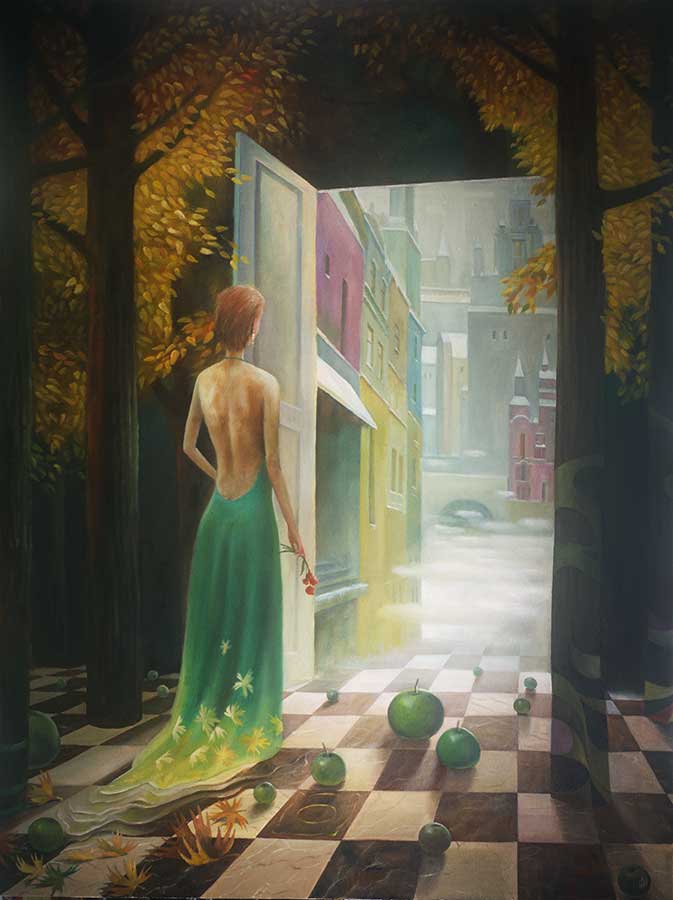


I once promised to write about my own inspiration, but I've been struggling to gather my thoughts. Not because my creative well has run dry, but because I'm too lazy to make a trip to the liquor store. The international situation is such that a hand holding a glass is often misconstrued.
Moving on to a different topic, when my wife said "I do" at the registry office, she might have secured her place in heaven, as she has to endure a lifetime of my shortcomings and my rather unpleasant character. I always seem to be unhappy and hungry. Unlike most women, she finds herself frequenting grocery stores rather than clothing boutiques. Although, to be fair, we do have stores that sell both sausages and clothes nearby, and it takes her an entire day to pick the right sausages. She insists that her wardrobe, including her dress, jacket, shoes, sneakers, and even earrings featuring Biden's portrait, were all acquired prior to our wedding. So, I often grumble quietly, lest she drown out my complaints with her indignant cries.
My character's most vexing aspects are my innate suspicion and a deep-seated distrust of authority. My inherent suspicion aligns with my astrological sign, which corresponds to some arthropod, and my skeptical attitude toward authority developed on the day of Glasnost's arrival, like many born in the USSR. Although the era of openness was relative, my skepticism was absolute.
Now, let's take a five-minute break from the art history lessons and the teachings of Soviet art professors. Art historians can tell you an artist's birthdate, marriage, and even the day they died, but the overall assessment of their work can vary widely depending on the hemisphere of the brain or the region of the world.
In the USSR, you were considered an artist if you held a diploma and could depict Lenin accurately. I'm not joking; I had to deal with it. But what's an artist with a family to support and expensive materials to buy supposed to do when the masses can't afford their masterpieces? The only option is to either remain penniless due to a lack of demand or compromise with the bureaucracy. In the latter case, the discomfort is offset by awards, titles, and income. As a result, generations of artists grew up with the understanding that any still life with daisies required, even if invisibly, a party membership card. Even when communism's path was obstructed, the essential issue remained the same, and the tradition of portraying artists as impoverished and without pants became even more pronounced. The authorities decided whether to reward the artist or bury them in their own work and toss them under a bulldozer.
If you expect me to start praising the West, you're mistaken. There's a different kind of membership card here, one with the American president's portrait. It turns out that you can make a living as an artist. Therefore, marketing skills often overshadow artistic talent. Media, auctions, exhibitions, and galleries layer on the hype to obscure the true intentions.
Feel free to throw stones at me, but I prefer the American approach. Despite my limited marketing knowledge and a lack of business genes to inherit, I still have a chance to make a living. Of course, it required hard work and the development of my unique concept.
If you're still curious, let's set aside most art history textbooks and ask a different question: Why do people create art in the first place? I've previously mentioned that the majority of biological systems on our planet tend to form groups, like trees in forests, birds in flocks, and, not to forget, ants and people. Communication typically involves sound signals and gestures, but humans took it a step further, inventing words and images. Drawing, however, is a complex skill not everyone possesses. So, nature, being frugal, gave images additional functions, such as connecting with religion and magic. This is common knowledge.
But let me make a bold assumption: let's add emotional understanding to the list. Not formulas or levers, but something inexplicable, akin to the desire to float up to the ceiling of a concert hall during a performance.
From this notion, the idea of creating emotional art with audience participation emerged and took shape. My hands, my skills, my overall concept, but every viewer has the right to their interpretation, shaped by their emotions. Often, artists are constrained by their circumstances and society, but viewers can "see" in a piece what the artist felt and conveyed associatively. In this sense, the artist isn't a god, saying, "Look and admire," but a participant who initiates a conversation. Since it's a conversation on equal terms, the artist must set aside their ego and adhere to the conversation's rules and topic. If it's contemporary art, the artwork should reflect that, and if it's philosophy, appropriate references should be present. This begs the question: Where does the artist fit in? That's where the fun begins.
I'll share my thoughts on this topic next time.